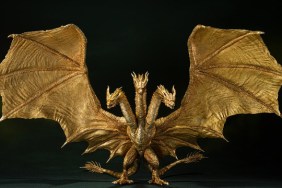That was the first sight to reveal itself, completely unexpected, as I walked the unassuming stretch between the parking garage and the main building of the Manhattan Beach-based Marvel Studios. Still a few hundred feet in the distance, the costume was unmistakable, not belonging to Thor himself, but to one of his Asgardian brothers. Armored, caped and massive despite the distance, the shape turned and began heading back inside. Seeing him move to the door, I fought the urge to break into a sprint for a closer look, as though the flash sight of an Asgardian warrior would mark a fleeting high point for the day. Instead, the gateway to the Marvel Universe was about to open in full.
Arriving at the front door, I joined a small band of journalists, soon greeted by Marvel Studios’ head of production, Kevin Feige and Thor co-producer Craig Kyle. They’re a funny pair, Feige having built up a coy showmanship atop his obvious pride for the production and Kyle holding nothing back, grinning ear to ear like the rest of us at the chance to be a part of every fanboy’s dream.
The first stop on our tour was a production office, the walls littered with sketches and design blueprints for every character, paired against large blown-up panels from classic Jack Kirby and Walt Simonson art. Loki was the first to catch my eye, the costume not at all a far cry from his classic look, right down to a long-horned helmet. Next to him is his brother (and, of course, the star of the film), Thor, clad in the familiar flowing red cape and clutching his hammer, Mjöllnir.
In the center of the office, the room expanded to include storyboards and tables covered in models and miniatures, including a two-up of a familiar villain, The Destroyer. In the comic, The Destroyer is an enchanted suit of armor that Loki takes charge of and uses to do battle with Thor. Though Feige is mum on its role in the film, images on the wall made it seem that The Destroyer will appear in the film’s New Mexico scenes and is prepped to do extensive damage to a Southwestern town, represented in full with a scale model in an adjacent room. In the center of the town, as we saw after the end credits of Iron Man 2, is Thor’s hammer, crashed within a large crater and surrounded by an army of miniature S.H.I.E.L.D. trucks.
While there wasn’t enough time to soak in the room’s hundreds of drawings, fantastic teases of Asgard stood out, including frozen, starry-skyed planetscapes and, most incredibly, the Rainbow Bridge, slightly tipped towards verisimilitude as a prismatic road of energy rather than the opaque rainbow of the comics. Another wall showed off some action for Odin, depicting the All-father with incredibly large biceps as he rages against what looked to be a Frost Giant. It was unclear whether this would be a special effect in the film or if this image was just taking in some artistic license with Anthony Hopkin’s physique.




